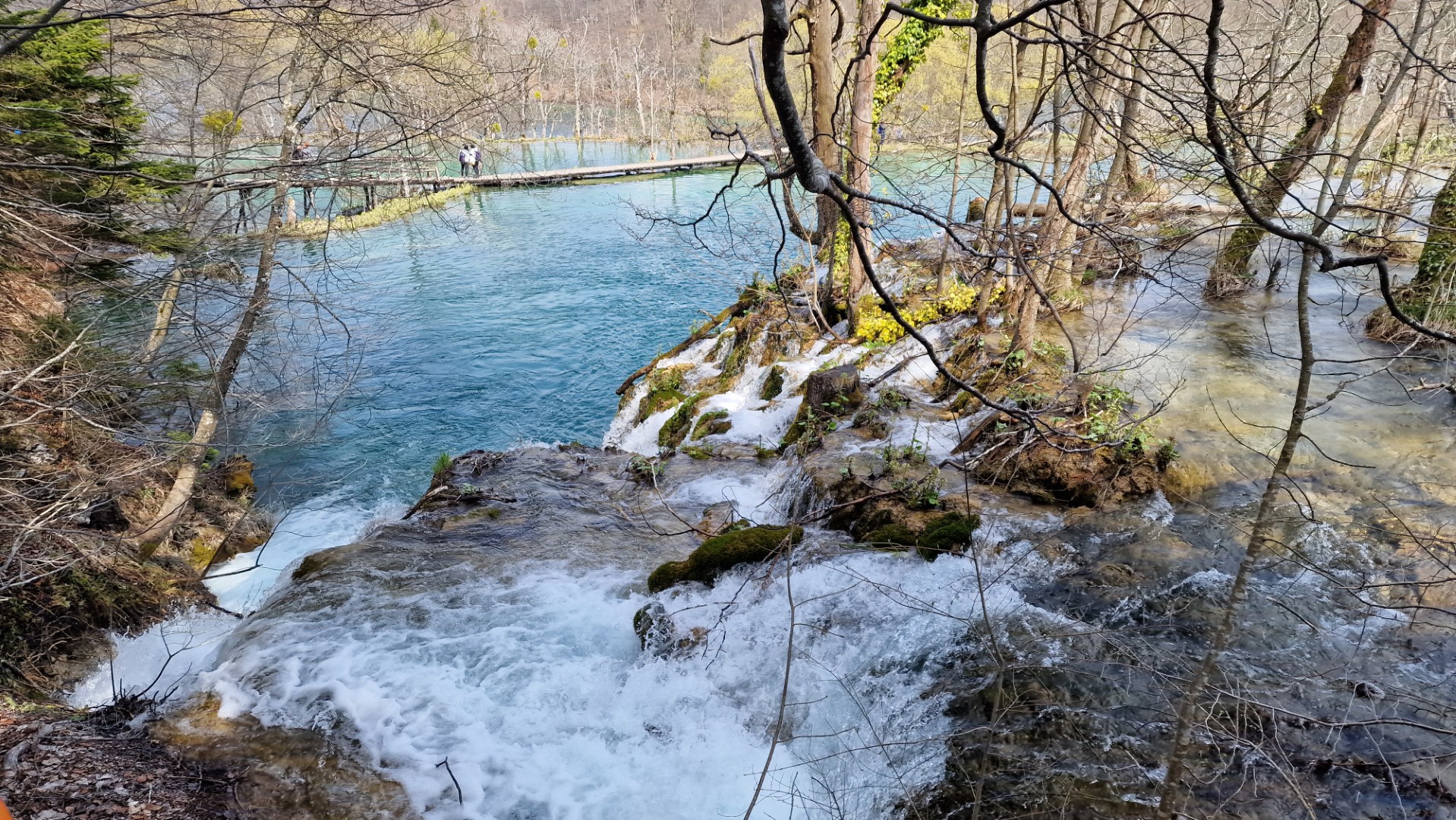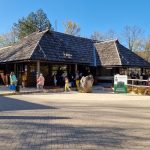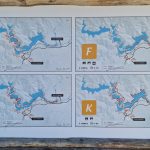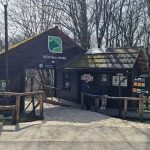Crystal-clear turquoise pools, thundering waterfalls, and emerald forests—Plitvice Lakes National Park sits on every “world’s most beautiful” list for good reason.
Sixteen interlinked lakes and more than ninety cascades create a living postcard, unveiling a fresh, jaw-dropping view at every turn of the boardwalk. Founded in 1949 as Croatia’s first national park and listed by UNESCO since 1979, Plitvice promises a one-of-a-kind brush with nature.
This guide pulls together everything you need—from ticket tips and trail advice to the best seasons for photography. Curious about the details? Use the embedded links to dive into our specialized articles packed with local insight, so you head out fully prepared.
Plitvice Lakes at a Glance
- 🌍 Location: Central Croatia, Lika region (44.88 °N / 15.62 °E), about 80 mi/130 km from Zagreb and 96 mi/155 km from Zadar
- 📐 Protected area: 296 km² (about 114 mi²) of national-park land
- 💧 Lakes: 16 visitor-accessible (90+ karst lakes in the wider system)
- 🏅 UNESCO status: Inscribed in 1979
- ⏰ Typical summer hours: Entrances 7 a.m.–8 p.m.; boats and panorama buses shut down a bit earlier
- 🎟️ Entrance fees: See here. Tip: make an online reservation to make sure you can enter the park in your desired time period.
- 🚗 Parking: About €1.50–2 per hour for cars; separate rates for motorcycles, buses, and RVs
- 🌐 Official website: np-plitvicka-jezera.hr
Why Visit Plitvice?
Travertine dams tint the water an almost unreal shade of turquoise, while tiered waterfalls supply a backdrop so cinematic you’ll swear it’s CGI. The water has been depositing travertine for millennia, building new barriers and reshaping the landscape before your eyes—a rare geologic process UNESCO now celebrates.
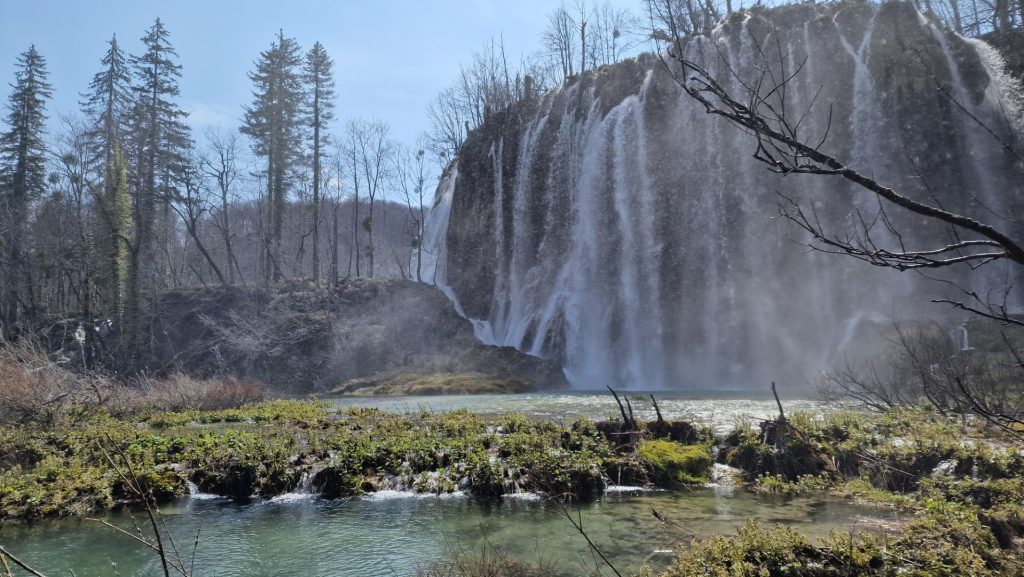
Circular boardwalks let you get “nose-to-nose” with the falls while protecting the fragile ecosystem beneath your feet, so Plitvice works for everyone—families, photographers, or anyone craving a leisurely nature walk.
And each season offers its own magic: roaring spring runoff, summer’s lush greens and cool shade, autumn’s fiery reds and golds, or winter’s lace-frozen waterfalls. No matter when you arrive, the park shows a brand-new face.
History & UNESCO Background
On April 8 1949 the Presidium of the People’s Republic of Croatia declared the area a national park, locking in long-term protection for its karst lakes and forests. Thirty years later, in 1979, UNESCO recognized Plitvice for its “exceptional natural beauty,” “ongoing karst formation,” and rich biodiversity.
The Yugoslav Wars severely damaged the park; UNESCO placed it on the List of World Heritage in Danger in 1992. After major restoration and stricter conservation rules, Plitvice came off that list in 1997, and its buffer zone was expanded in 2000 to cover the full 29 630 ha.
Today strict visitor quotas, cutting-edge water-quality monitoring, and constant research safeguard the park for future generations.
Geography, Geology & the Lake System
Carved into limestone and dolomite of the Dinaric Alps plateau (2 090–1 650 ft / 636–503 m), the lakes are fed by calcium-rich karst springs. As water tumbles over cascades it builds travertine dams that thicken by roughly half an inch (1 cm) per year with help from mosses and algae.
The 16 lakes form 2 separate geographical levels, and are accessible by the many market hiking trails:
- Upper Lakes (Gornja jezera) – 12 basins, including 2 094 ft/638 m-high Prošćansko and the largest, Kozjak; broad valleys and dense forest dominate.
- Lower Lakes (Donja jezera) – 4 basins winding through a 130–200 ft/40–60 m limestone canyon, ending at the 256 ft/78 m Veliki Slap, birthplace of the Korana River.
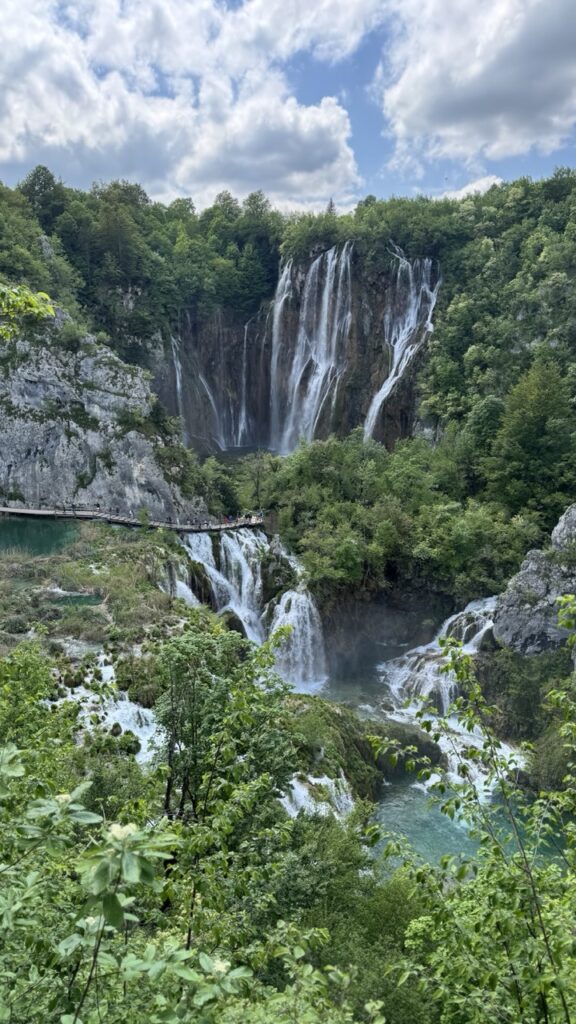
The hydro engine is the merger of the Crna and Bijela Rivers, which feed the Upper Lakes. Eight kilometers downstream the water meets Plitvica Creek at Sastavci Falls and officially becomes the Korana. Walk the boardwalks and you’re in an open-air geology lab where every drop is busy crafting tomorrow’s waterfalls.
When to Visit? – Quick Seasonal Comparison
| Season | Avg. Temp. | Scenery & Water Flow | Crowd Level | Traveler Tip |
|---|---|---|---|---|
| Spring (Mar–May) | 40–60 °F / 5–15 °C | Peak flow, roaring falls, fresh green | Moderate; Easter sees a bump | Aim mid-April, pack rain gear |
| Summer (Jun–Aug) | 63–73 °F / 17–23 °C (afternoons to 83 °F / 28 °C) | Turquoise water, stable weather, leafy shade | Very busy—hourly slots vanish fast | Book 30 days out, arrive 7 a.m. sharp |
| Autumn (Sep–Oct) | 50–64 °F / 10–18 °C | Red-orange foliage, medium flow | Pleasantly thinning | Sept. “second summer,” foggy photo ops late Oct. |
| Winter (Nov–Feb) | 27–39 °F / –3–4 °C (nights to 14 °F / –10 °C) | Icy falls, snow-dusted walks | Minimal | Only main trails open; layer up |
July–Aug. avg. ~63 °F / 17.4 °C; January avg. ~35 °F / 2 °C.
- Spring = water-curtain show – Meltwater supercharges the falls; expect slick boardwalks but epic power.
- Summer = postcard colors + crowds – Up to 12 000 guests a day vs. a 1 200-per-hour limit; arrive ticket-in-hand.
- Autumn = artist’s palette – Fewer tour buses, rich reflections through October.
- Winter = ice fairytale – Frozen lakes reward hardy souls with near silence.
Getting There – In a Nutshell
- By car – Exit the A1 motorway at Karlovac or Gornja Ploča, then follow the scenic D1 highway; Zagreb to the park takes roughly 2 hours / 85 mi (136 km), Zadar about 1.5 hours / 75 mi (120 km).
- By bus – Up to 15 daily coaches from Zagreb (fastest 1 h 50 min), 4–6 from Zadar (~1 h 45 min); fares start around €13–18, with online booking recommended.
- By air – Fly into Zagreb (ZAG) or Zadar (ZAD) and continue by rental car or bus.
Need turn-by-turn routes and parking hacks? See our separate guides on getting there from Zagreb, 1-Day Trip From Zagreb to Plitvice-Lakes, and our “How to Get to Plitvice Lakes” section for more cities.
Tickets & Booking Guide
Plitvice runs a time-slot system: choose an entrance (1 or 2) and an arrival hour when you buy. With a 1 200-visitor hourly cap, summer entry (June–Sept) is basically online-only.
Ticket types – at a glance
- 1-day & 2-day passes (the latter covers consecutive days)
- Categories: adult, student, child (7–18), group; kids 0–6 and visitors with ≥ 50 % disability enter free
- Late-day discount: cheaper after 4 p.m.; winter prices drop sharply
- What’s included? Boat ride across Lake Kozjak, panorama bus, basic insurance
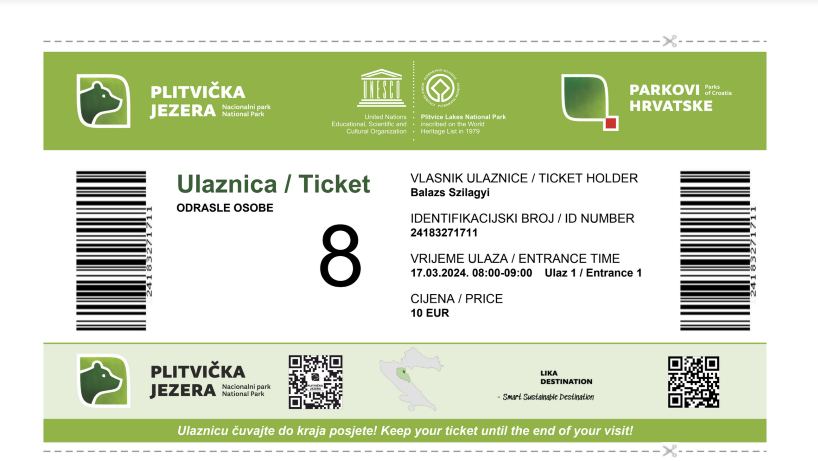
Booking tips
- Buy online – lock in your date/time weeks ahead on the official website; save the PDF offline for patchy reception zones.
- Be punctual – enter within your slot or buy a fresh ticket (if any remain).
- Flex = save – early morning or late afternoon means smaller crowds and lower prices.
- Two-day hack – staying in a park hotel? Reception can extend a 1-day pass to day two.
For live prices see our constantly updated “Plitvice Ticket Prices” article.
Official Hiking Routes – Snapshot
Eight color-coded loops span everything from an easy 2-mi/3-km stroll to the full 11-mi/18-km grand circuit. All are loops, so you finish where you start, and each ticket covers the Kozjak boat and panorama bus.
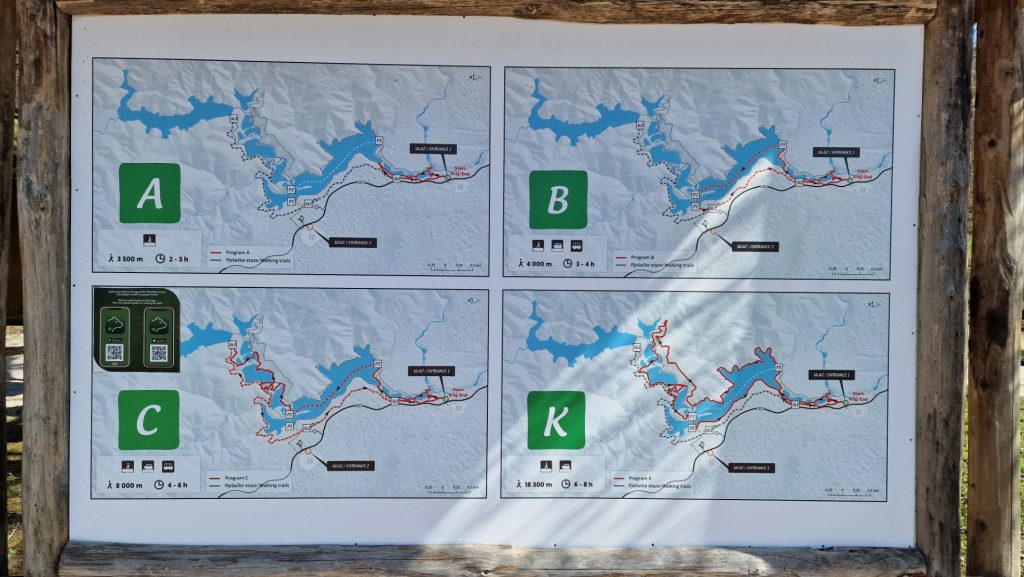
- Duration scale: ~2 h (short Lower-Lakes loops) → 4–6 h (mixed circuits) → 6–8 h (full “K” route)
- Difficulty: mostly flat boardwalks; longer loops demand stamina, not skills
- Start points: Entrance 1 or 2—match route length to your booked slot
- Customize on the fly: trails intersect often; shorten or extend as you like, then hop the next boat or bus
Detailed maps and minute-by-minute itineraries live in our “Plitvice Lakes NP Hiking Trails” article.
Gear & Clothing Checklist
Year-round essentials
- Grippy hiking shoes/boots—boardwalks can be wet or mossy
- Waterproof shell or poncho—weather flips fast
- Layered clothing—temps can swing 18 °F / 10 °C in a day
- Sun protection—hat, sunglasses, SPF 30+
- 24–34 oz / 0.7–1 L water bottle—refill points are sparse on longer loops
- Energy snacks—pack out your trash
- Power bank & offline map—cell service is patchy
- Mini first-aid kit—band-aids, pain reliever, tick tool
Seasonal add-ons
| Season | Pack this | Why |
|---|---|---|
| Spring | Waterproof pants, spare socks | High spray, slick boards |
| Summer | Breathable tee, insect repellent | Heat & mosquitoes |
| Autumn | Micro-fleece, light gloves | Foggy mornings, cool ridges |
| Winter | Insulated boots, hat & scarf, micro-spikes | Icy boards, frigid nights |
Photo gear (beyond a phone)
- Polarizing filter—cuts glare, deepens turquoise
- ND 8-16 filter—silky-water shots at ¼–1 s even in daylight
- Compact tripod—under 12 in / 30 cm so you don’t block the boardwalk
Pro tip: the entrance gift shops sell ponchos, but at a serious markup.
Rules, Etiquette & Conservation – in brief
- Stay on the boardwalks—travertine is fragile and fines apply.
- No swimming, fishing, or drones—to protect water quality and wildlife.
- Leave No Trace—carry out all trash; smoke only in marked zones.
- Dogs welcome—leash required, and muzzles on boats.
Accommodation – in brief
- Inside the park: Hotels Jezero, Plitvice, and Bellevue—pricey, but you get early entry and a peaceful night.
- Nearby villages (Rakovica, Plitvička Jezera): family-run apartments, B&Bs, glamping tents—good value even at peak.
- Campgrounds: Camp Korana (bungalows + tents) and Camp Borje—great for road-trippers.
Read our accommodation experience and tips following this link
Food & Drink – in brief
- Park restaurants: Lička Kuća (traditional grill) and Poljana (cafeteria); expect lines in high season.
- Local specialties: janjetina ispod peke (slow-roasted lamb) and štrukli cheese pastry.
- Veggie/vegan: options are limited but growing—look for plant-based burgers and salads at larger cafés.
- Picnic tip: pack a light sandwich and fruit—the Upper Lakes have few snack stops.
Click this link to find our own personal Plitvice Lakes restaurant experiences and tips.
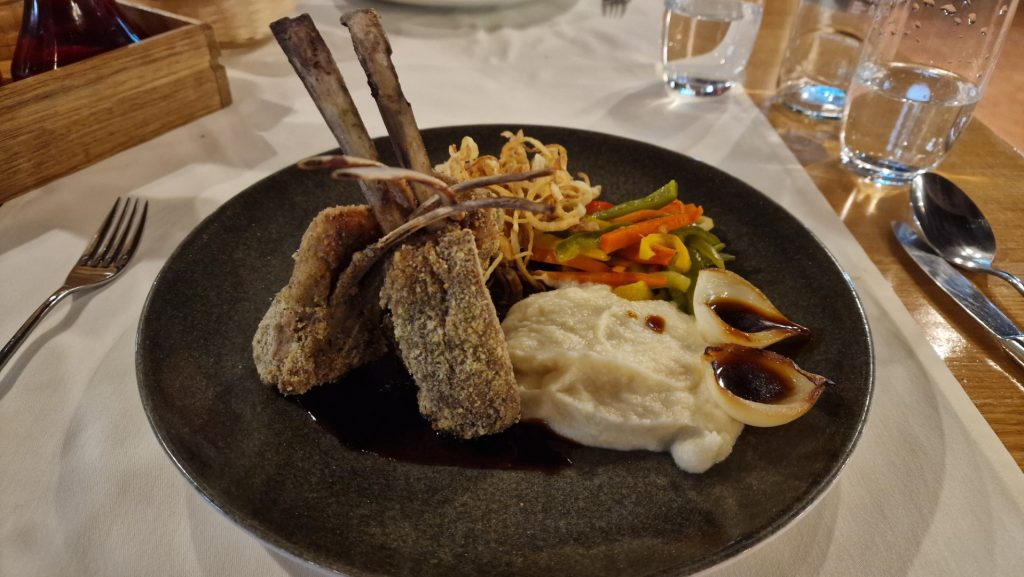
Flora & Fauna Kaleidoscope
Flora – 1 400 species, 75 endemics
Roughly 30 % of Croatia’s plant diversity is packed into 114 mi²/296 km². Spring carpets of cyclamen and primrose give way to summer water lilies, while about 60 orchid species—including the showy lady’s-slipper—hide beneath the beech-fir canopy.
Fauna – stronghold of large predators
- Large mammals: brown bear, gray wolf, Eurasian lynx, European wildcat, and otter thrive in the dense forests—proof of a healthy ecosystem.
- Birds: around 160 species—golden eagles soar overhead, dippers bob in the streams, and black woodpeckers drum in the woods.
- Fish: pristine, carbonate-rich water hosts trout, chub, and a handful of endemic caddis larvae; fishing is off-limits.
- Insects & butterflies: 320+ species, including endemic caddis flies like Drusus croaticus; dragonflies patrol summer boardwalks.
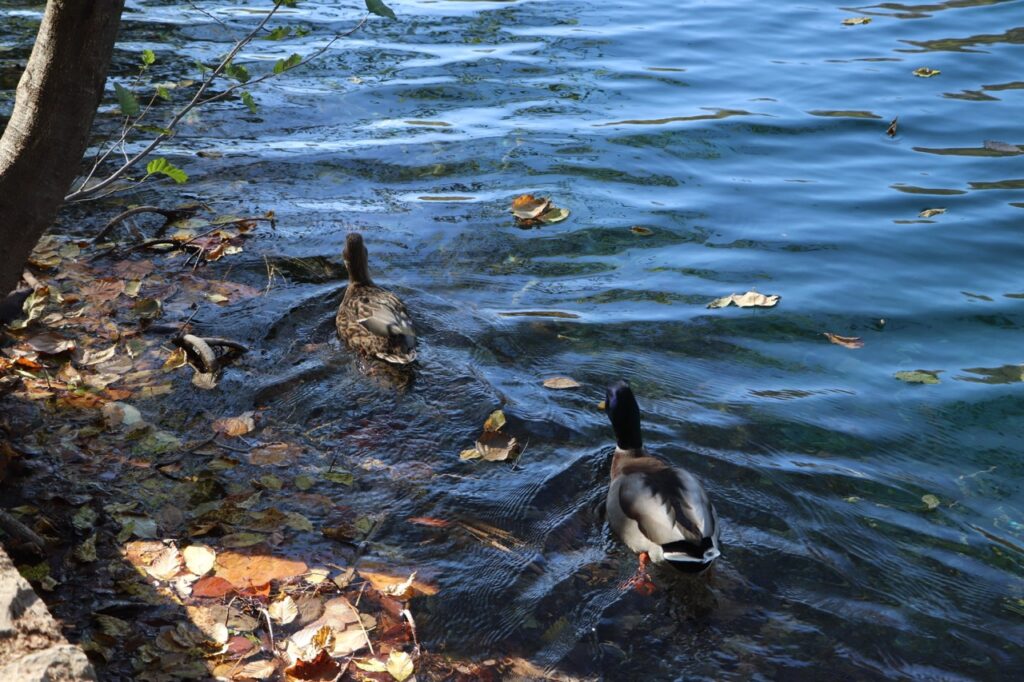
Spotting tips
- Go early or late—more wildlife activity, fewer people.
- Keep quiet & distant—never feed or chase wildlife; lynx and wolves stay deep in the woods.
- Binoculars & telephoto—great for birding; drones are banned park-wide.
One day here can take you from orchid glades to bear tracks—if you stay observant and respect the park’s ground rules.
In a Nutshell
Plitvice delivers fairy-tale scenery and a live geology lesson—within easy reach of several major Central European cities. Whether you crave spring’s water-curtain spectacle, summer’s postcard hues, autumn’s color riot, or winter’s ice sculptures, the park reveals a fresh face each season.
We’ve packed this guide with essentials—seasonal timing, booking know-how, gear tips, and wildlife highlights. For deeper dives into routes, tickets, or photo workshops, explore our related articles.
Next step: pick your dates, reserve a time-slot ticket on the official webshop, and start writing your own Plitvice story!
Reference
When writing this article, other than our own experience, we used the following sources:
- Plitvice Lakes NP – Hours of Operation (official website) (Nacionalni park “Plitvička jezera”)
- Plitvice Lakes NP – Price List (official website) (Nacionalni park “Plitvička jezera”)
- UNESCO World Heritage Centre – Plitvice Lakes National Park (UNESCO World Heritage Centre)
- Plitvice Lakes NP – 75th anniversary news (Nacionalni park “Plitvička jezera”)
- Climate-Data.org – Plitvice Lakes klímaátlagok (Climate Data)
- Plitvice Lakes NP – Protocol for Photography & Filming (Nacionalni park “Plitvička jezera”)
- Plitvice Lakes NP – Orchids overview (Nacionalni park “Plitvička jezera”)
- Insight Vacations blog – Fauna (Insight Vacations)
- Contiki blog – Travertine growth ≈ 1 cm/year (Contiki)
- Freshwater Project – Travertine growth rate (Roggo Photography)
- FlixBus – Zágráb ↔ Plitvice bus (1 h 45 min) (flixbus.com)
